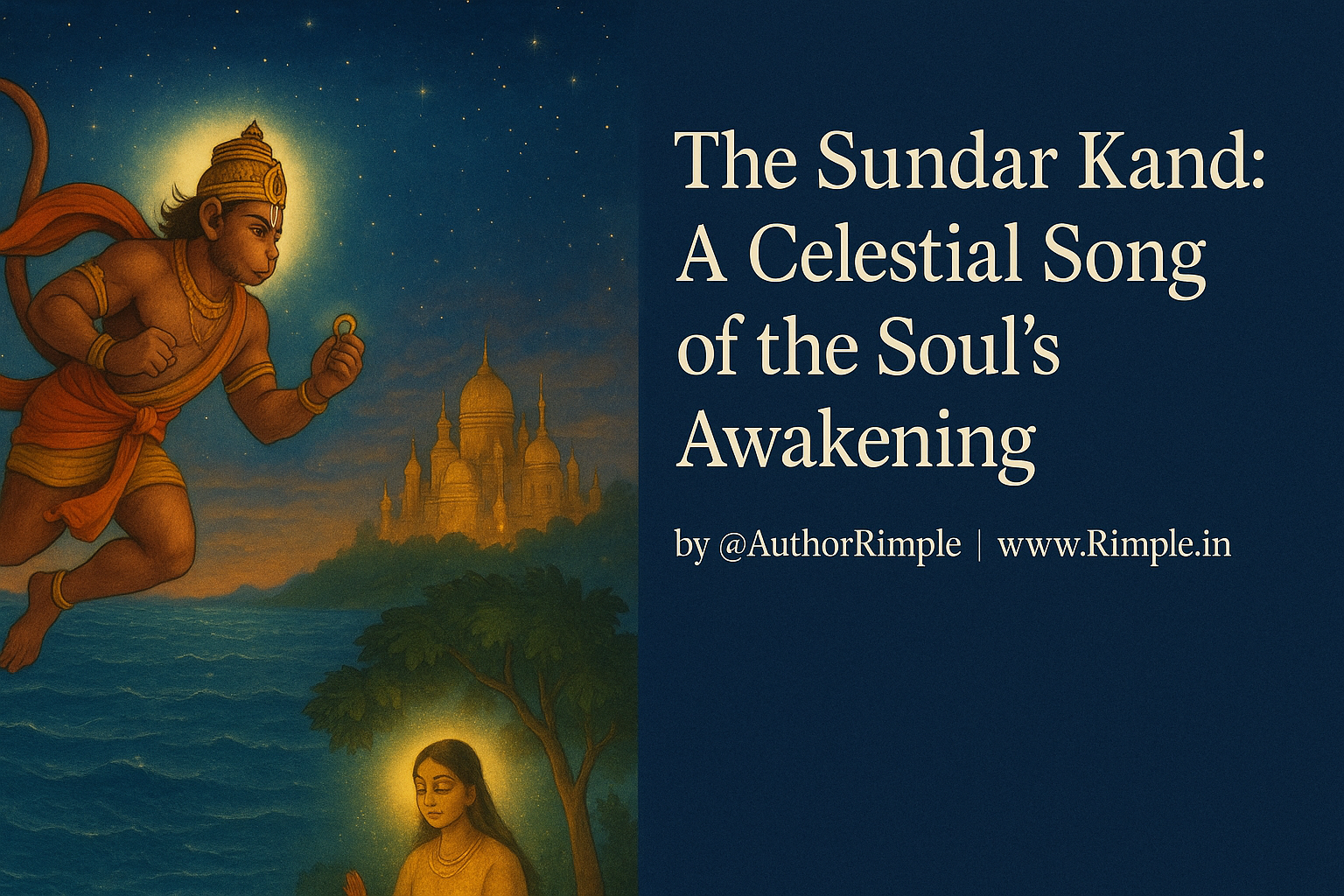In the eternal tapestry of Hinduism’s Pauranic history, there shines a chapter so luminous, so divine, that it stirs the deepest chords of the heart. This is the Sundar Kand, the radiant heart of every Ramayana, a sacred symphony that echoes across time, from Valmiki’s ancient verses to Tulsidas’ soulful Ramcharitmanas. It is the story of Hanumanji’s sacred search for Mata Sita, a journey that transcends the physical to become a celestial quest for the soul’s hidden light. Oh, how beautiful is the Sundar Kand! It is not merely a tale—it is the soul’s odyssey, a divine melody that unveils the glory of Shri Ram, the eternal truth, and Hanumanji, the Bhakt whose heart beats with boundless Bhakti.
Imagine a golden city, Lanka, gleaming with desires, its towers of gold whispering promises of pleasure and power. Yet within its walls, Mata Sita, the embodiment of divine consciousness, sits in the Ashoka Vatika, yearning for Shri Ram, her heart pure amidst the chaos of temptation. Lanka is not just a place—it is the world of our desires, where our soul, our Sita, is trapped, longing to be freed. And Hanumanji, the mighty Bhakt, becomes the seeker, diving into the ocean of existence to find that hidden spark, that inner voice, that divine potential buried within us all. The Sundar Kand is this sacred journey—a poetic dance of discovery, a hymn of awakening, a call to reunite with Shri Ram, the divine essence within.
Let us immerse in its divine flow, let its verses wash over us like a sacred river, and let its truth draw us into the eternal embrace of Hinduism’s timeless wisdom.
The Heart of Every Ramayana
The Sundar Kand is the beating heart of every Ramayana, from the ancient Sanskrit of Valmiki to the soulful Awadhi of Tulsidas. Across cultures and languages, it tells the same divine story: Hanumanji’s quest to find Mata Sita, his trials, his triumph, and his return to Shri Ram with her message of hope. In Tulsidas’ Ramcharitmanas, the Sundar Kand blooms with poetic beauty, its dohas and chaupais shimmering with Bhakti. But its essence transcends any single text—it is the universal tale of the soul’s search for its divine source.
The narrative begins with Shri Ram, the embodiment of dharma, standing on the shores of an endless ocean, His heart heavy with love for Mata Sita, who is held captive in Ravana’s Lanka. His vanara army, led by Sugriva, falters in doubt, but Hanumanji, the son of the wind, rises like a flame of Bhakti. Jambavan, the wise bear, awakens Hanumanji’s inner strength with words that echo through the ages:
Doha in Devanagari:
जामवंत के बचन सुहाए। सुनि हनुमंत हृदय अति भाए॥
तब लगि मोहि परिखेहु भाई। जब लगि नहिं रघुपति की नाई॥Meaning in English: Jambavan’s sweet words touch Hanumanji’s heart, igniting a divine spark. “Test me as you will, O brothers,” he says, “but none can compare to Shri Ram, the king of Raghus.” This doha is a clarion call, awakening Hanumanji’s latent power, reminding us that our own potential lies dormant until stirred by faith in the divine.
With Shri Ram’s name as his mantra, Hanumanji leaps across the ocean, a mighty arc of Bhakti soaring over waves of doubt. He faces trials—Surasa, the demoness, tests his resolve; Mainaka, the mountain, offers rest—but Hanumanji’s heart is fixed on Shri Ram. He reaches Lanka, a city of gold, where every glittering tower tempts the soul with desires. Yet in the quiet Ashoka Vatika, he finds Mata Sita, her heart an unbroken flame of Bhakti for Shri Ram. Hanumanji offers her Shri Ram’s ring, a symbol of hope, and receives her message of love to carry back.
Doha in Devanagari:
राम दूत मैं मातु सिता के। प्रभु चरननि सनेह तव नेके॥
नाम जपत मंगल दिसि दसहू। तुम्हरि प्रेरित रामहि जसहू॥Meaning in English: “I am Shri Ram’s messenger, O Mother Sita,” declares Hanumanji. “Your love for Shri Ram’s feet is pure. By chanting His name, all directions become auspicious, and inspired by you, I sing His glory.” This doha is a bridge of Bhakti, uniting Mata Sita’s longing with Shri Ram’s grace through Hanumanji’s selfless service.
Hanumanji’s journey does not end with finding Mata Sita. He confronts Ravana, boldly proclaiming Shri Ram’s might, and sets Lanka ablaze with his fiery tail, a divine fire that burns away illusion. Returning to Shri Ram, he delivers Mata Sita’s message, his words a balm to Shri Ram’s heart, strengthening the path to righteousness.
Doha in Devanagari:
सुनि सिय बचन परम सुखु पावा। हनुमंत रघुपति पहिं गावा॥
सुनत कृपानिधि मन अति भाए। प्रेम मगन सिय चरित सुहाए॥Meaning in English: Hearing Mata Sita’s words, Hanumanji feels supreme bliss and returns to Shri Ram, singing her message. Shri Ram, the ocean of compassion, is deeply moved, immersed in love for Mata Sita’s beautiful virtues. This doha captures the divine reunion of hearts, where Hanumanji’s Bhakti becomes the thread that weaves Shri Ram and Mata Sita together.
The Spiritual Essence: A Quest for the Soul
The Sundar Kand is more than a chapter of Pauranic history—it is a mirror of the soul’s journey. Lanka, with its golden spires and intoxicating pleasures, is the world of our desires, where the mind is swayed by wealth, power, and illusion. Mata Sita, pure and radiant, is our divine consciousness, trapped in the Ashoka Vatika of worldly attachments, yearning for reunion with Shri Ram, the eternal truth within us. Hanumanji, the mighty Bhakt, is the seeker within—the spark of courage, the whisper of faith, the hidden potential that lies dormant until awakened by Shri Ram’s grace.
When Hanumanji leaps across the ocean, it is the soul crossing the vast sea of ignorance, braving doubts and temptations to find its true essence. His search for Mata Sita is our quest to hear the inner voice, to rediscover the divine light buried beneath layers of desire. Lanka’s glitter cannot sway Hanumanji, just as true Bhakti remains untouched by the world’s allure. When he finds Mata Sita, it is the moment the soul beholds its own divinity, pure and unshaken, waiting to be reclaimed.
Doha in Devanagari:
हनुमान कीन्ही प्रभुता सागर परसि गयौ।
राम काज सजग भयो निज बल बुद्धि बिसरायौ॥Meaning in English: Hanumanji crossed the ocean, touching its waters with divine power. For Shri Ram’s cause, he became vigilant, forgetting his own strength and wisdom in service. This doha reveals the surrender of ego, where Hanumanji’s Bhakti becomes a beacon for the soul to let go of pride and embrace divine purpose.
The burning of Lanka is the soul’s triumph, a sacred fire that consumes illusion and reveals truth. Hanumanji’s return to Shri Ram, carrying Mata Sita’s message, is the soul’s homecoming, where the inner light reunites with the divine source. The Sundar Kand whispers to us: your potential is vast, your consciousness is divine, and Shri Ram’s grace is ever near to guide you home.
Why Bhakts Chant the Sundar Kand
The Sundar Kand is a sacred chant, a divine nectar that flows into the hearts of Bhakts. Its verses are recited in homes, temples, and hearts, for it carries the power to transform:
- To Awaken Inner Strength: Hanumanji’s leap teaches us to tap into our hidden potential. When life’s oceans seem vast, the Sundar Kand stirs the courage within, reminding us that Shri Ram’s name is our strength.
- To Deepen Bhakti: Every doha is a love song to Shri Ram, drawing Bhakts into His divine embrace. Chanting it fills the heart with love, making Shri Ram’s presence a living reality.
- To Find Peace Amidst Chaos: Like Mata Sita in Lanka, we are surrounded by desires. The Sundar Kand shields us, bringing peace and clarity, with Hanumanji as our protector.
- To Reclaim the Soul: The Sundar Kand is a call to seek our inner Sita, to free our consciousness from the golden chains of worldly illusion and reunite with Shri Ram.
Families gather under starlit skies, their voices rising in unison, chanting the Sundar Kand to invite blessings, dissolve fears, and purify the heart. Its words are a divine current, carrying Bhakts to the shores of Shri Ram’s grace.
The Divine Call of Hinduism
The Sundar Kand is a jewel in the crown of Hinduism, a tradition that sees the divine in every breath, every soul. It is not just a story—it is a living truth, a path to awakening. Hanumanji’s Bhakti shows us that Hinduism is a celebration of surrender, where the ego dissolves in the light of Shri Ram’s love. Mata Sita’s steadfastness reveals the resilience of the soul, pure even in the heart of desire. Shri Ram’s compassion reminds us that the divine is not distant but dwells within, waiting for our call.
Doha in Devanagari:
रामचन्द्र गुन बरनत हियँ हरषत हनुमान।
जयति रघुबर भक्त बल सागर सिव सनमान॥Meaning in English: As Hanumanji sings Shri Ram’s virtues, his heart dances with joy. Victory to Shri Ram’s Bhakt, whose strength is an ocean, honored even by Shiva. This doha is a hymn of triumph, celebrating Hanumanji’s Bhakti as a path to the divine, a light for every Bhakt to follow.
The Sundar Kand beckons us to Hinduism’s heart, where Bhakti is the key to liberation, where every soul is a spark of Shri Ram’s light. It teaches us to seek our inner Sita, to burn away the Lanka of desires, and to soar like Hanumanji toward the divine. Its verses are a sacred river, washing away doubt and filling the heart with divine love.
A Divine Invitation
Oh, Bhakts of Shri Ram, let the Sundar Kand be your guiding star, your sacred song! Chant its dohas, let Hanumanji’s courage awaken your soul, and let Shri Ram’s name be your eternal mantra. In its verses, find the beauty of your hidden potential, the radiance of your divine consciousness. Let Lanka’s gold fade before the light of Bhakti, and let Mata Sita’s faith inspire your heart to seek Shri Ram.
The Sundar Kand is a divine call to embrace Hinduism’s timeless wisdom—a path of love, service, and truth. It is a whisper from the divine, urging you to discover the Sita within, to soar with Hanumanji’s Bhakti, and to rest in Shri Ram’s eternal embrace. Sing its verses, and let your soul dance in the light of Shri Ram’s grace, chanting forever: Jai Shri Ram! Jai Hanuman! Jai SiyaRam!
Also Read:





